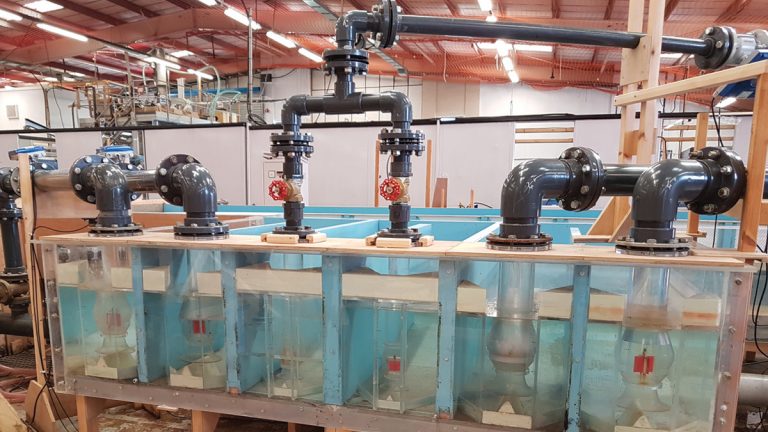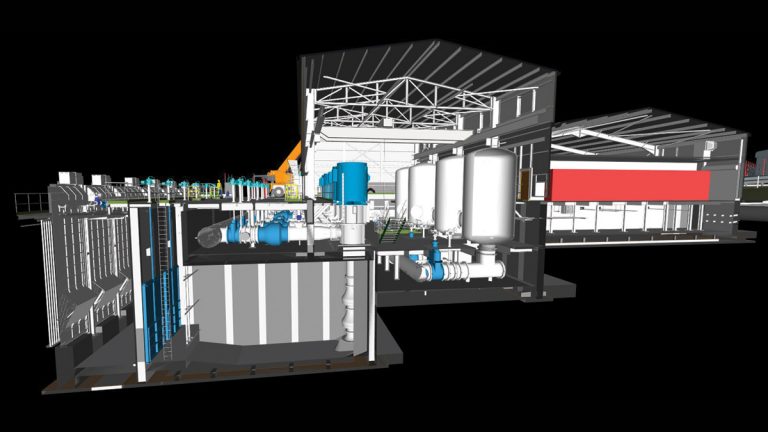Prioress Mill Raw Water Pumping Station (2018)

Existing Prioress Mill RWPS Intake - Courtesy of Arcadis
Prioress Mill Raw Water Pumping station (RWPS) is located in Rhadyr, near Llancayo, Monmouthshire, on the south bank of the River Usk. It abstracts at a rate of up to 318 ML/day, and is the primary supply to Llandegfedd reservoir, which then feeds Sluvad Water Treatment Works (WTW). Prioress Mill RWPS has been identified by Dŵr Cymru Welsh Water as a high-risk asset due to operational issues with the installed mechanical and electrical equipment, which is nearing the end of its serviceable life.
Background
The existing Prioress Mill Raw Water Pumping Station was constructed in the early 1960s and comprises:
- Intake trash screen with associated bosker grab to remove large debris.
- 4 (No.) penstocks fitted above the channel that feeds the intake sump.
- 2 (No.) drum fine screens of approximately 9m diameter.
- 10 (No.) shaft driven centrifugal pumps (5 (No.) ‘small’ pumps at 475kW and 5 (No.) ‘large’ pumps at 675kW which are approximately 35 years old) with extended carbon shafts and 3.3kV fixed speed motors in a dry well arrangement.
- 4 (No.) surge vessels which are located within a separate reinforced concrete structure.
The existing pipework within the pumping station is ductile iron. The station pipework connects to a 60” pre-stressed concrete common main that then splits to 48” and 42” diameter parallel pre-stressed concrete delivery mains within the site boundary to the west of the main building. The pipeline then continues in this fashion for the majority of its total length (approximately 4.6km), before combining to a 60” pre-stressed concrete main that discharges to Llandegfedd Reservoir.

Existing site constraints – Courtesy of Arcadis
Changing requirements
The current station is unable to comply with the changing requirements demanded of the site, which are intended to reduce its impact on the Usk and its local ecology.
As part of a review of the Usk and Wye catchment area, Natural Resources Wales (NRW hereafter) has introduced new abstraction constraints at Prioress Mill, which the current station is not able to meet without extensive modification. The existing intake screening facilities also do not meet the requirements of the Habitats Directive and Fish and Eel Regulations. From a design perspective, this limits the acceptable velocity of the abstracted flow.
An option to refurbish the existing station was considered; however, this was not feasible within the programme constraints and would have involved reusing the sub-optimum sump arrangement of the existing station. The agreed option is thus to demolish and replace the existing station with a new pumping station.
Site constraints
With an ancient woodland upstream, listed property downstream, and a flood plain opposing, the most feasible location was to locate the new station within the current DCWW boundary adjacent to the existing station. As the current station must remain live until the new station is built, the space constraints are significant.
The new station is bounded by the existing station to the east, the river to the north, the existing pipelines to the south, and HV overhead electric cables and woodland to the west. Only once the new station is in operation can the existing station be de-commissioned and demolished, with the site then re-landscaped to suit the new station.

Proposed station layout – Courtesy of Arcadis
Design process
The DCWW Alliance is a relatively new entity, and the implementation of true collaborative working, and BIM will take time. The implementation of true collaborative processes requires a degree of contractual incentive amongst partners, and the implementation of BIM software and process a significant amount of retraining of personnel. Whilst the concepts and advantages are often well understood, the implementation is at a varying level across the industry.
As a key scheme within the Welsh Water Capital Delivery Alliance, the strategy of the design team for Prioress Mill has been to only use the parts of BIM that can be effectively used by the team and give a visible benefit to all those involved. In this way, a greater buy in from all parties has been achieved. Design development has successfully occurred in 3D via the holding of regular model reviews using Autodesk BIM360 Glue.

Laser survey with proposed model superimposed – Courtesy of Arcadis
Adding to this, the use of a CDE for the Skanska-Arcadis team (SharePoint), the project has successfully embraced a weekly collaborative design process. Issues are identified and marked up by any member of the team, and all members of the team and supply chain have access to the federated model via Glue.
Following mark-up, the model review (in the form of a conference call with shared desktop) then gives a check/author stage before mark-ups are moved to an approved changes folder from which modellers can work. The modellers can then directly view the changes required using the Glue mark-up and make the changes in their respective software.
To date Autodesk Revit has been used, which provides a simple gluing process back to the federated model in BIM360 Glue once the mark-up has been actioned. With this established position, the 3D model has also been trialled for estimator take-offs (5D) and is currently being used to test the phasing of construction (4D). The use of BIM360 Field for construction progress reviews and commissioning is also planned, when the project enters further into the construction stage.

Typical BIM360 Glue mark-up – Courtesy of Arcadis
New station design
The constraints and client requirements for the new station has driven a design focused on efficiency in space and operation, whilst also offering minimal maintenance requirements and a long lifespan. With efficiency in mind, 6 (No.) vertical turbine pumps with variable speed drives have been selected, providing from 21ML/day up to a potential 382 ML/day. The arrangement is of 4 (No.) ‘big’ pumps (duty/assist/assist/standby) and 2 (No.) ‘small’ (duty/standby), giving a total station power requirement of 5.3 MVA to deliver peak flows.

Proposed pumping station 3D model – Courtesy of Arcadis
Eel screens
The new Hydrolox vertical travelling belt screens require positioning in line with the river flow. This, along with the constraint of the existing pipelines to the south, essentially sets the front of the station and associated forebay behind the screens. To protect the screens from impact with large debris regularly carried by the river, trash bars are installed just in-front of the screens.
To stop leaf and other small floating debris building up, a physical floating boom has been designed. This is held away from the screen front by tensioned cables on the inner edge to ensure the boom does not migrate and impede the screens. With the flow through the screens being limited in velocity, and a high degree of flexibility required by Welsh Water, 7 (No.) screens have been included in the design. This allows for the possibility of high abstraction rates even with relatively low river levels.
Pump bays
The layout of pump bays and associated sump behind the screens was drafted to the Hydraulic Institute standards as a start point. The sump depth was then optimised to reduce the excavation of bedrock, with physical modelling commissioned to ensure any undesirable hydraulic phenomena within the sump was designed out. With such a variation in flow rates and potential river levels, a variety of phenomena were present in the initial design.

Physical model setup – Courtesy of BHR
The improvements made to the sump design were to increase the size of the penstock openings into the sump (reducing local losses/velocity which could cause jets to form), extend the length of dividing walls for each individual pump bay (preventing larger flow recirculation within the sump), and add specific benching arrangements local to the pump bellmouth (reducing swirl and mitigating against vortex formation).
In terms of physical space, the use of vertical turbine pumps and a reverse common manifold has allowed for key flow meters and surge control vessels to be housed within one pump hall building.
This improves on the current station where flow meters, surge control, and the pump halls are separated throughout the site. Having key items of plant housed inside also aids their lifespan and gives a better working environment for maintenance. To facilitate simple maintenance of the plant, the building is designed to allow for a flat-bed/low loader size vehicle to reverse in and be directly accessed via the pump halls overhead gantry crane.
Surge basement
The use of a ‘surge basement’, where surge pipework and the bottom of the vertical vessels reside, has also allowed for a neater access arrangement for operation/maintenance of the valve actuators. Similarly, a cable basement level has been designed beneath the smaller connected MCC hall, where the associated variable speed drives and control panels are housed. Having a physical basement allows for any possible re-design of the control panels and drives whilst still being able to use the overall structure.
Stability and erosion control
With the River Usk having a wide range of potential levels, and significant destructive capability, the reinstatement of the bank temporarily removed during construction was also a key design area. The construction of the station necessitates the removal of vegetation that helps to maintain the stability of the existing bank.
To provide effective stability and erosion control, precast concrete gravity blocks, with a return into the bank on the upstream side, are proposed. The blending of these hard structures into the existing bank is then facilitated with a graded re-vegetated slope, utilising rock rolls to protect the toe and coir pre-seeded matting on the surface.

Proposed station internals – Courtesy of Arcadis
Existing mains tie-in
Possibly the most critical point for the project is the 90° tie-in to the existing mains, which must be conducted during a changeover period between old and new stations. Due to the criticality of the station’s operation, a variety of thrust restraint options have been assessed to find the most suitable in terms of install time and simplicity, as well as longevity and suitability to the ground conditions.
The chosen proposal makes use of a reinforced concrete slab keyed into the bedrock, restraining the thrusts in one direction, with the other direction being tied back to the station and resolved within the station pipework. This minimises the work required within the existing pipeline footprint, and thus the time taken to changeover the stations connected to the existing pipelines.
Table of designers, contractors and suppliers (May 2018) – All acting within the Welsh Water Capital Delivery Alliance
- Client: Dŵr Cymru Welsh Water
- Principal contractor: Skanska
- Lead designer: Arcadis
- Design & installation of temporary dam: Kaymac Marine & Civil Engineering Ltd
- Geotechnical investigation: Geotechnics Ltd
- Physical modelling: BHR
- Hydraulic surveys: Hydraulic Analysis
- 3D surveys: Tetramec
- Intake screens: Hydrolox
- Main delivery pumps: Bedford Pumps
- HVAC: ATS (Air Technology Systems)
Current progress and future challenges
Other key challenges the project has endured relate largely to the ecology, with dormice and otters both present within the site.
In addition, existing 66kV and 11kV overhead power lines have been diverted, and the careful mitigation of Hogweed and other invasive plant species undertaken. One of the key challenges ahead will be in the careful staging of the switchover of the old to the new station. This will require careful planning around the spatial constraints posed when having both stations fully built in close proximity, and then in having the subsequent demolition and infill works of the old station adjacent to the now running new station.

Proposed station section – Courtesy of Arcadis
In this scenario, having the 3D model is invaluable, and a key focus has been to keep the model as detailed as possible. The use of the model as a communication tool is still possibly its greatest asset, and this becomes ever more apparent as more suppliers come on-board, and supplier design is scrutinised and integrated into the federated model.
At the time of writing (May 2018) the project is at a stage where the main civil works are underway, with main mechanical and electrical works planned for the following year. The scheme is targeted to be commissioned and delivering water by the end of 2019.













